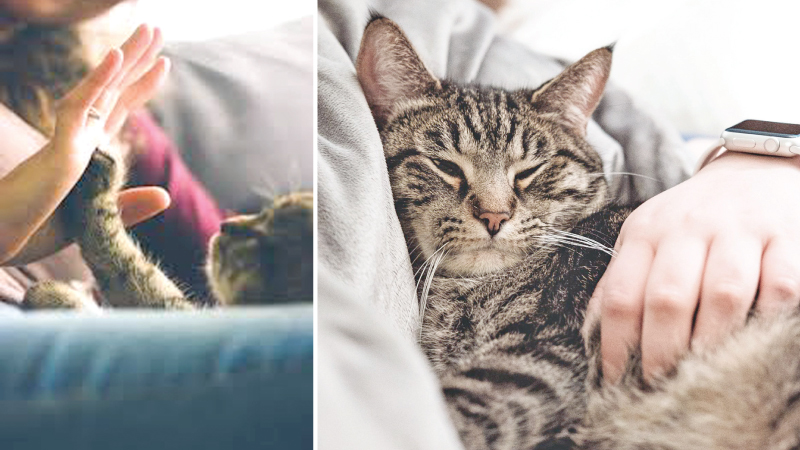Cats have long been companions to humans with their soft purrs and gentle nature bringing comfort to human lives. But do you know that beyond being lovable pets, cats are increasingly recognised for their therapeutic potential? They soothe emotional distress faced by us and research on cats show that these feline friends do play a significant role in enhancing mental well-being.
Understanding Animal-Assisted Therapy
Animal-assisted therapy (AAT) involves the use of animals to improve human health, both physically and mentally. While dogs often take the spotlight in this field, cats hold a unique place, especially for people who find the independent, calming presence of felines more suitable. Unlike dogs, cats don’t demand constant attention, making them ideal for people who may feel overwhelmed or intimidated by overly energetic animals.
Cats naturally create a serene environment. According to research, their rhythmic purring has been shown to have physiological benefits. Studies suggest that the frequency of a cat’s purr, typically between 20 and 140 Hz, can reduce stress and anxiety, lower blood pressure, and even promote healing in bones and tissues. These remarkable qualities make cats valuable allies in the realm of mental health.
The cat-human bond
The bond between humans and cats can be deeply therapeutic. For people dealing with loneliness, depression, or grief, the quiet companionship of a cat offers solace. One of the significant research findings is that stroking a cat’s soft fur releases oxytocin, often called the “love hormone,” that creates feelings of happiness and connection. The simple act of petting a cat can ground people in the present moment, distracting them from intrusive thoughts or emotional pain.
Why most of us love cats so dearly os that cats also provide nonjudgmental companionship. Unlike humans, they don’t offer advice or opinions. This lack of judgment can be particularly comforting for those struggling with self-esteem issues or feelings of inadequacy. A cat’s unconditional acceptance creates a safe space where people can process emotions without fear of criticism.
Cats in Psychotherapy
Psychotherapists are increasingly incorporating cats into their practice. In a therapeutic setting, cats help create a relaxed atmosphere, which is especially beneficial for clients who find traditional therapy sessions intimidating. The presence of a cat can break the ice, making it easier for clients to open up.
For children and adolescents, cats can serve as a bridge to therapy. Young clients who are reluctant to engage with a therapist may feel more at ease when a cat is present. Interacting with the animal can also provide insights into the child’s emotional state, offering therapists valuable cues.
For people with post-traumatic stress disorder (PTSD), cats offer a grounding presence. Their predictable routines and calming behaviours can help mitigate feelings of hypervigilance and anxiety. Clients often find that caring for a cat gives them a sense of purpose, encouraging them to establish routines and focus on positive, nurturing interactions.
Cats and emotional regulation
Emotional regulation is a cornerstone of mental health, and cats excel in this area. Their soothing presence can help people manage intense emotions, whether it’s anger, sadness, or anxiety. The act of caring for a cat—feeding, grooming, or simply spending time with it—encourages mindfulness. This focus on the present moment can be a powerful tool for those struggling with emotional dysregulation.
Cats possess a natural ability to mirror human emotions. They often respond to their owner’s mood, offering quiet companionship during times of sadness or playful antics when their human is cheerful. This empathetic behavior reinforces the bond between cat and owner, providing a sense of emotional stability.
While cats offer many benefits, it’s important to recognise that they are not a universal solution. Sadly, not everyone feels comfortable around animals, and some people may have allergies or phobias. Cats also have their own personalities and may not always exhibit the behaviors needed for therapeutic purposes.
Selecting the right cat for therapy involves careful consideration. Cats used in therapeutic settings should be calm, well-socialised, and comfortable around people. Their well-being must also be prioritised, as stressed or unhappy animals cannot provide effective support.
You don’t need to be in formal therapy to experience the benefits of a cat’s companionship. Simply sharing your home with a cat can provide emotional comfort and a sense of purpose. Creating a nurturing environment for your cat—providing toys, scratching posts, and cozy sleeping spots—ensures a happy and fulfilling relationship for both of you.
For those unable to own a cat due to allergies, living situations, or other constraints, cat cafés offer an alternative. These establishments allow visitors to interact with cats in a relaxed setting, offering many of the same emotional benefits without the long-term commitment.
The science behind the connection
The therapeutic effects of cats are not merely anecdotal. Research supports their ability to improve mental health.
Studies have shown that spending time with cats can reduce cortisol levels, a hormone associated with stress. Regular interaction with a cat can also boost serotonin and dopamine levels, promoting feelings of happiness and well-being.
Cats encourage routines. Feeding, grooming, and playing with a cat create a daily structure, which can be particularly beneficial for individuals recovering from mental health challenges. These routines provide a sense of normalcy and achievement, reinforcing positive habits.









